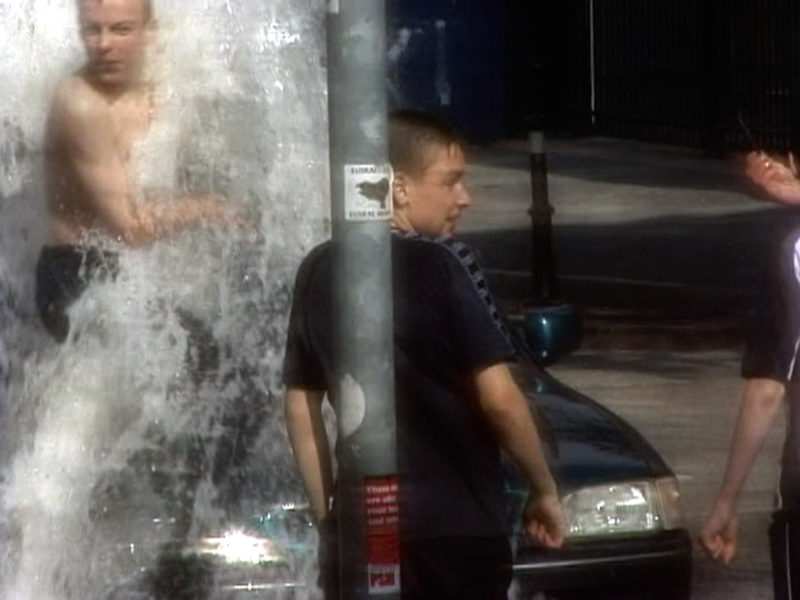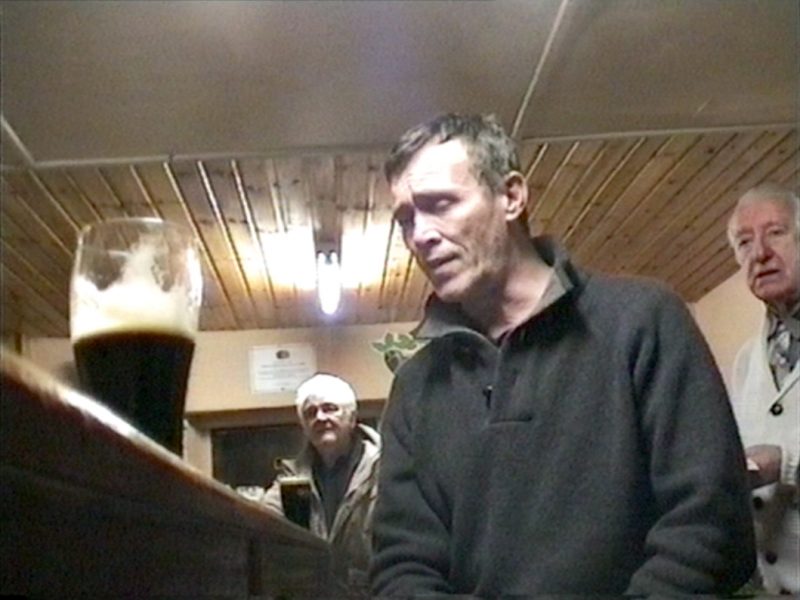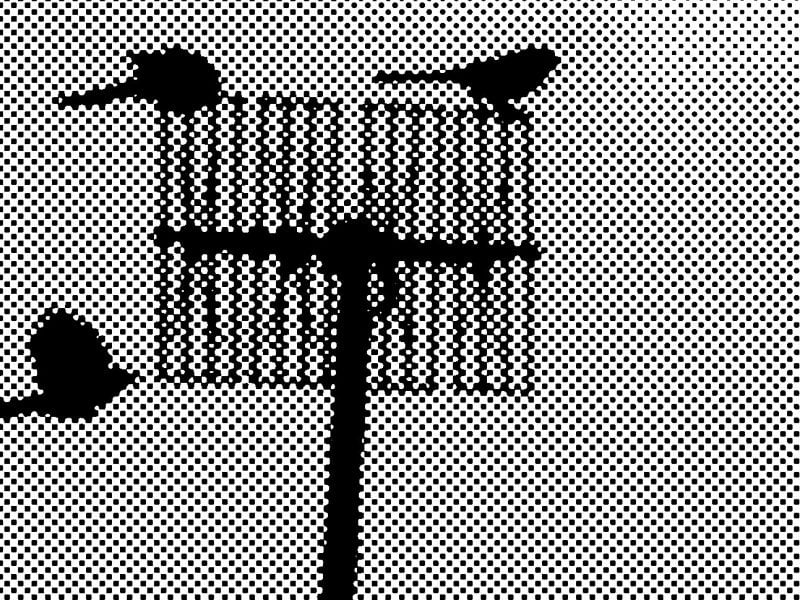Seamus Harahan was born in London in 1968 and grew up there and in East Tyrone. He lived in Belfast for most of his adult life. In addition to being a filmmaker, Seamus is an accomplished musician, and could be found partaking in traditional Irish music sessions in bars around Belfast. Seamus also produces experimental noise and electronic music and constructs or rebuilds his own synths, drum machines and effects pedals. Seamus’ films are shot using handheld, avowedly amateur cameras and techniques, and they express a highly instinctual and responsive sensibility that is very attentive to detail in the world around us, sharply and compassionately so, when it comes to the subject matter of his work. Seamus won the 2015 Film London Derek Jarman Award, a major recognition that has been long overdue. His work has not been given funding, partially because it does not have a preconceived idea or design that can be fitted agreeably in advance into the box-ticking, spreadsheet version of art decreed by the managers of today’s culture. Seamus’ practice tends to allow things to happen in all their randomness or unpredictability. However, his work is also very carefully composed and edited rather than simply being a passive relay of events. Both visually and musically, his works are skilfully and thoughtfully rendered and arrive at a heightened awareness that is fostered by an astute eye for detail and an ear for music that is in constant dialogue with what we see, either by juxtaposition and contrast or subtle combination and confluence.
In many ways, Seamus’ visual art finds affinity with the poetic openness to experience found in Louis MacNeice’s ‘Snow’: ‘World is suddener than we fancy it. / World is crazier and more of it than we think’.[1] In MacNeice’s poem, the lack of the definite article – ‘the’ – in these lines very cleverly makes ‘World’ arrive more quickly than expected for the reader, without preparation or pre-emption. So too, Seamus’ films refuse to inflict a prior conceptual design upon the work, as instead ‘World’ comes to the artist who must then respond to the ebb and flow of life. At the same time, nonetheless, artistic purpose is found in how the material is then shaped and edited. Seamus’ style was very humble rather than declaring itself but its unobtrusiveness should not obscure its meticulous and considered perception. Seamus’ work deftly interweaves the momentary and the monumental; it illumines the phenomenal in the apparently transitory phenomena to which it brings clarified attention. There is something of the epiphany in many of Seamus’ films, something quite empathetic and democratic too, which brings into communion the art itself – low-cost by necessity rather than design – and its subjects, since in both cases there is an affirmation that art is possible anywhere and that anywhere is possible for art, that it is possible for anyone to be part of art’s protectorate as a subject and that it is possible for anyone to be an artist. It is an egalitarian aesthetic in terms of both how the work is made without costly preconception and technical apparatus and in its generous affinity with its subjects.
Seamus’ aesthetic is distilled by East of The River Nile (2002), which is structured around fugitive shots of three lost souls in Belfast city centre – a homeless man, a stray dog and then a second homeless man – soundtracked by an Augustus Pablo song that provides the work with its title. Seamus has stated that his filmmaking seeks ‘a dislocation of the familiar’. East of the River Nile cleverly disrupts narrative expectations: initially it appears that the first homeless man is scavenging the area, lifting detritus from the street and taking cardboard from a bin. As such, the film almost invites a certain kind of viewer to assume that it is simply a do-it-yourself reiteration of state surveillance and the CCTV regulation of city centres in which the unwanted and undesirable are to be watched, policed and tracked, in case their illicit wanderings flout the law or disrupt the city’s orderly civics. However, it slowly emerges, as passers-by come into shot, that this sequence is being played in reverse. While these passers-by walk backwards, our understanding of the scene is strikingly re-orientated by the revelation that the man is tidying up the area and placing the cardboard in the bin.
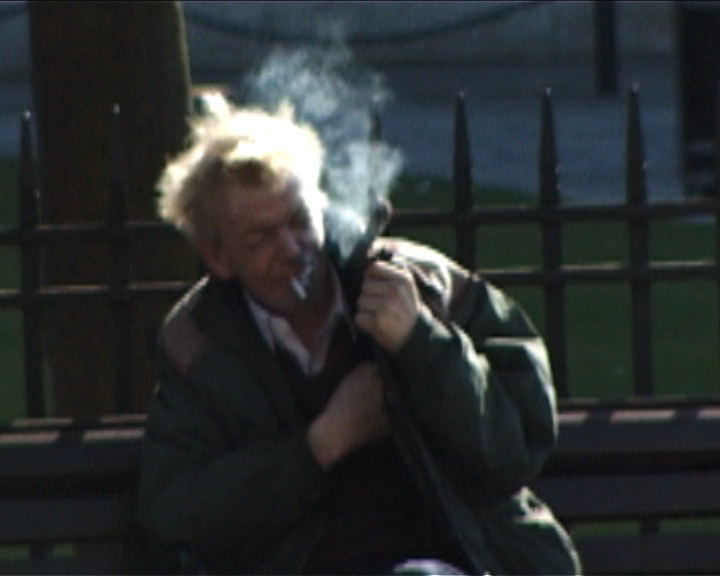
East of the River Nile, Seamus Harahan, 2002
Part of the film’s skill allows the homeless man to emerge as a kind of urban saint, preserving civic duty in a place that he is not allowed to own or belong to, at the same moment that his supposed betters, the citizens and proprietors, stroll idly by without care. A major facet of the film’s own thoughtfulness resides in finding a moment of thoughtfulness by this homeless man that would otherwise be lost in the customary navigation of this space by Belfast’s established citizens and by regimes of surveillance. The film locates redemption in itinerant itineraries and vagrant vagaries rather than accepted routes and viewpoints. The brief middle section of East of the River Nile then follows a stray dog seeking out food from the streets and any form of attention or compassion from passers-by. Visually the film equates the life of this dog with the experiences of the homeless men which frame this section and once more the work is on the side of the vanquished and dispossessed.
The use of Augustus Pablo as the soundtrack invokes Rastafari and a hybrid, resistant culture borne out of displacement and in search of home that adds resonance to the feelings and plight of the subjects of this film. There is also something implicitly self-referential about the choice of music at an artistic level, since Pablo made his own melodica, a handheld and nominally low grade instrument commonly associated with children learning music at a formative stage. Augustus Pablo’s mastery of a disdained piece of apparatus to make music speaks to the technique of Seamus’ own handheld camera and its capacity to make art. Additionally of course, Pablo’s reggae and his composite ‘Far East’ style which gathers instruments and influences from across the globe also bespeak an art attuned to piecing together fragments, redeeming the cultural remnants of dispossession. The second homeless man in East of the River Nile is seated outside Belfast City Hall, the central symbol of civic power, and he is filmed from the other side of the busy thoroughfare, Chichester Street, which runs past the front of the city hall so that our view of him is interrupted by traffic. As this man lights up a cigarette, there is a brief moment, as he looks to the sky when he inhales and then exhales, wherein the sunlight confers upon his face and grey hair a kind of halo in a moment of transcendence. The film also captures the weariness ingrained in the man’s face and demeanour but still offers this moment of lambent transfiguration before the man is obscured by the passing traffic. East of the River Nile decentres the city, both literally and symbolically, given its attentiveness to this man beside Belfast City Hall before he is lost in the ongoing commercial throng. This film rescales what is deemed important through a more humane calibration, whose quantum vigilance recovers the lost and discarded in the heart of the city, the arteries of which are exposed as being full of commercial traffic and empty of compassion.
Mr. & Mrs. Compost (2013), which was filmed from the balcony of Seamus’ home in North Belfast and takes its title from a piece of ambient folk by Bibio, is also distinguished by a knowing disruption of well-worn wisdom and the criminalizing eye of surveillance. In the case of regimes of surveillance and the contemporary use of their footage as popular cultural entertainment in the glut of Reality TV programmes about crime these days, Mr. & Mrs. Compost would seem to offer would-be voyeurs a gang attacking one of the houses in the street, kicking in the door and smashing windows. However, in keeping with the promise of pastoral redemption amidst darkness in the film’s soundtrack, it transpires that we are watching small, local acts of heroism as the men are trying to save the resident of the house from a fire that is engulfing the property. Part of the magic of Seamus’ art resides in its capacity to disrupt expectation and to redeem detail from the generalised torpor of presumption. Context is important here. Northern Ireland was the most heavily surveilled state in western Europe during the Troubles and it then provided the template for wider strategies of surveillance and containment that have become normative across many societies. The gaze of surveillance awaits only what it expects. It is monotonously looking for its objects to become typical, to revert to type (as threat, criminal act, predicted behaviour and deviance) so that it might generalise and justify its whole field of representation around its expectation. This CCTV regulation of place also partakes in a longstanding tendency to see Northern Ireland as an already fated place where outcomes are predetermined and inevitable. During the conflict there was always a prevailing view – at governmental, policy, legal and mass media levels – of the North as an irresolvable tribal dispute that was mired in an almost mythically repetitive and reiterative stasis, impervious to the goodwill of liberal democracy. Hence, mainstream political discourse about Northern Ireland spoke in a lexicon of ‘cycles of violence’, ‘tit-for-tat killings’ or ‘things spiralling out of control’. Therein one thing inevitably follows another.


Free as a Bird, Seamus Harahan, 2006
In addition, space was portioned as belonging to one tribe or another, so that the apparent sectarian certainties of identity were cemented in agreed versions of place, all festooned by flags, murals and painted kerbstones demarcating one version of fixity or another. Seamus’ work renders such expectations and their established signifiers unstable. As Declan Long observes: ‘This is Belfast — but with few obvious markers of place, with hardly any of the expected geographical “certainties” associated with this city. Instead, Harahan cultivates — and celebrates — a heightened spirit of unpredictability about place’.[2] In Free As A Bird (2006), soundtracked by Cat Power’s cover version of Lynyrd Skynyrd’s ‘Freebird’ for a John Peel Session, there are shots of Divis Tower in the Lower Falls area of Belfast through a rain-soaked and grubby window pane, backgrounded by Black Mountain or Divis Mountain (from the Irish dubh ais) from which the urban tower block gets its name. Both are iconic in the representation of Belfast: Divis Tower was the site of numerous battles between local residents, Irish Republicans and the UK Army and is a symbol of resistance to British Rule (provocatively, having lost the street battles and unable to patrol on foot, the British Army built a military outpost on the roof of the tower accessible by helicopter), as well as being a potent reminder of social and economic deprivation and marginalization in the city; Divis or Black Mountain is the rural hinterland which curves around West Belfast and into which the city’s urban sprawl finally disappears and it has often been used nostalgically as the locus of redemptive longing for a different place outwith the Troubles.
Seamus’ film, taking its guide from the languorous and restless yearning in Cat Power’s voice which almost resignedly undercuts the freedom it seeks, and from the soaring flight of the gulls who move across the shot, brings a sense of place and displacement, ingrained stasis and desired movement into creative tension. The film then focuses upon a piece of graffiti: O.D.B. R.I.P. Cannily aware of the customary paramilitary acronyms on walls throughout the city – PIRA, INLA, UDA, UVF – the film selects graffiti memorializing O.D.B or Ol’ Dirty Bastard, the US rapper Russell Tyrone Jones, one of the founders of the Wu-Tang Clan who died in 2004. Already the edgy camera work and jolts in focus render two key Belfast symbols less static and secured than is usual in representations of the city and bring them into a vertiginous visual exchange interwoven by birds in flight, and to this conversation the graffiti brings a sense of elsewhere and of the presence of that elsewhere in the dialogue Belfast has with itself and the world. It is less that the city is a space of already agreed monologues endlessly reiterating to themselves and more that it is opened up as a place of exchange across cultures and boundaries.
However, Seamus’ work is neither blithely nor blandly a celebration of the city per se. It does not replace the arrested representation of Belfast as static tribal map with a newly dominant version of the city as diverse and pluralistic, the latter underpinning a lot of the mainstream discourse of the Peace Process in the North of Ireland and its dream of happy consumer-citizens populating a shared commercial space. The critical eye of Seamus’ vision is much more evaluative and dialectical: across his work we witness glimpses of how the city can be both heaven and hell, an impacted place which collides possibilities and delimitations. Where moments of redemption or possibility erupt in East of the River Nile, Mr. & Mrs. Compost or Free As A Bird, they do so against the grain of their own opposites: deprivation and unfreedom. There is a class consciousness to Seamus’ mapping of space and the moments of unlicensed freedom or fugitive civics garnered by his films must punctuate a cartography of poverty and marginalization. The episodic work, Cold Open (2014), which was shot from Seamus’ home in North Belfast over the course of a year, comparably searches amidst everyday life for sparks of humanity and imagination in a fenced-in, entrenched and socially marginalised environment. Once more there is an affinity between the work and its subjects, since the latter have next to nothing to do and are trying to make something happen or provide some meaning or togetherness in their lives. As such, there is a self-referential fellowship since Seamus’ practice also strives to retrieve meanings amidst apparently habituated outcomes or understandings and to allow us to be aware of things happening; his art is itself a record of things happening in unexpected or unsanctioned ways. Eilidh Ratcliffe writes that ‘Harahan exposes the careless, short-hand associations we make on a daily basis and challenges us to look beyond surface detail’.[3]
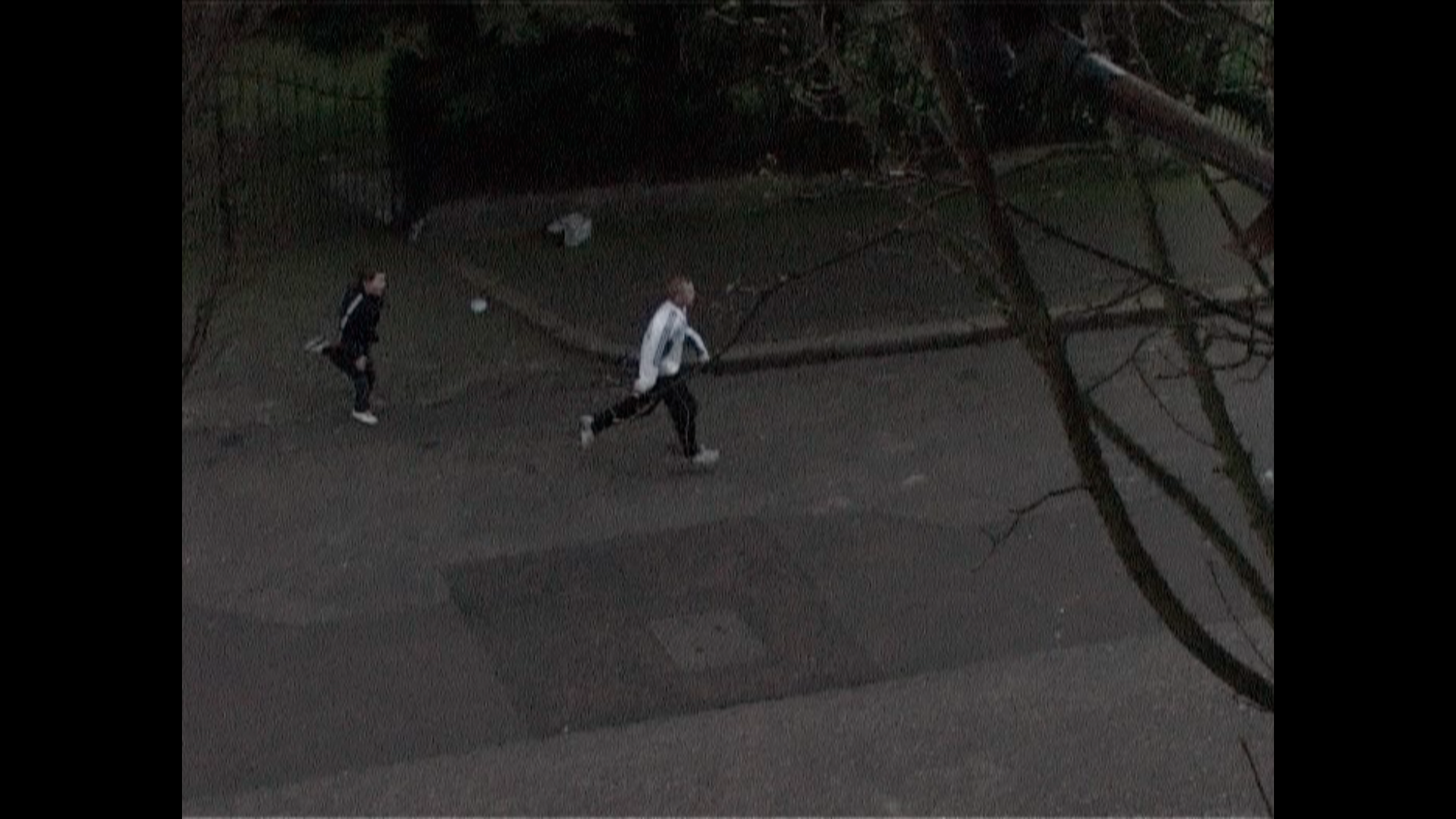
Cold Open, Seamus Harahan, 2014
Cold Open achieves the unsettling of lazy assumptions by both invoking a kind of neighbourhood watch or CCTV gaze, and all the attendant value judgements that go with these about anti-social behaviour, and then collapsing it by continually shifting perspective rather than enthroning an all-seeing eye. Both the work itself and its viewers become more implicated in what they see rather than identifying with a governing perspective and must think evaluatively and critically about how they are seeing and what they are seeing. Once more, the thoughtful use of soundtrack reconfigures meanings across this fragmentary epic. Although the choice of music might appear discordant to some, it actually retains a nomadic cohesion that crystallizes in yet another generous vision amongst grey, autumnal concrete and enclosed space. The piece ends with a song by German electro-progressive band YOU, which also sonically coalesces with the use of traditional Irish music in the film since at times alongside the electronica some of the synths seem to soar like mournful uilleann pipes, overlaid with Carol Batton reading her poem ‘Bee-ing’, the latter itself accompanied by a wistful flute that conjoins with the sound of YOU. The poem – ‘Listen you Dandelions! / Don’t try to be daisies’ – is very well suited to the visuals which happen upon a group of youths walking down the street, one of whom attempts to slide under the tall, newly fortified, iron fencing that has partitioned the local area, before running to rejoin his friends. Carol Batton’s poem is deftly energised with the tensions between entrapment and autonomy, between identity as burden or refuge, between the societal allocation of forlorn fates and the creative cultivation of fresh flourishing amidst the dreary duress:
‘Talk flowers, try to talk. Stop looking at each other askance. We are all insecure. Speak to each other. Communicate your plight. Share your doubts. Talk and tell of truth.
It will fill all that waiting, with meaning.’[4]
The sequences comprising Cold Open retain a mutable marginality interwoven with the discarded urban environments and lives depicted in the film, through a style that is both a capture and a release of meanings, and which finds affinity with the street-level, peripatetic edginess of its subjects rather than abstracting the perspective into a governing, pseudo-sociological overview of passive objects. The blending into the soundtrack of Seamus’ work of the blues classic ‘Lost John’ – the origins of which are in the African American work song celebrating the legendary flight of an escaped slave who fitted an extra heal to his shoes so that his pursuers could not follow his tracks – affords another understated declaration of affinity with the subjects’ quotidian bids for fugitive freedom in prohibitive, hostile terrain. The song is also another cultural touchstone and reference point for the guiding aesthetic of Seamus’ works: a tracing of lives off the beaten track but also a tracing of unbeaten tracks, of small-scale, ongoing and undefeated pathways of imaginative freedom and resistance amidst the city’s inbuilt cartography of geopolitical inequality and exclusion.
The area in which Cold Open is filmed is known locally as The Waterworks, as it was originally the site of reservoirs designed to supply water to the north of Belfast in the 1840s, but which was eventually passed to Belfast Corporation when it could no longer meet demand as the city’s population expanded in the second half of the nineteenth century. In fact, the Donegall family, landed gentry who owned the entire city of Belfast until 1844, had fraudulently sold the water rights to multiple bidders, resulting in legal disputes that ran until the 1860s. By the time The Waterworks did become fully operational, its original scaling and design were already insufficient to meet demand in the expanding city. The civic plan was for the site to become a resource for leisure activities, particularly of course for Belfast’s leisured classes but also for the city’s working class – there was provisional for boating and yachting as well as public baths and swimming – but most of the reservoirs were filled in for safety reasons by the 1950s having become increasingly neglected and dilapidated. Although there continues to be usage of the site as green space, a public park and wildlife reserve, The Waterworks, as with the remaindered municipal and public function of its original design and reuse as a leisure space, has always been, more negatively, an abandoned space dislocated from the heart of the city that has been scarred by violence and neglect, a voided non-place left behind by someone else’s disappointed, grand designs that have moved on to more lucrative, commercial areas and ventures. Cold Open, as with all of Seamus’ work, is very much an aesthetic and instinctive expression of solidarity with those who still try to navigate that non-place and its dead ends, to create brief utopias – to invoke the etymological sense of utopia as non-place – as provisional reclamations of the terrain that make it liveable and bearable and survivable.
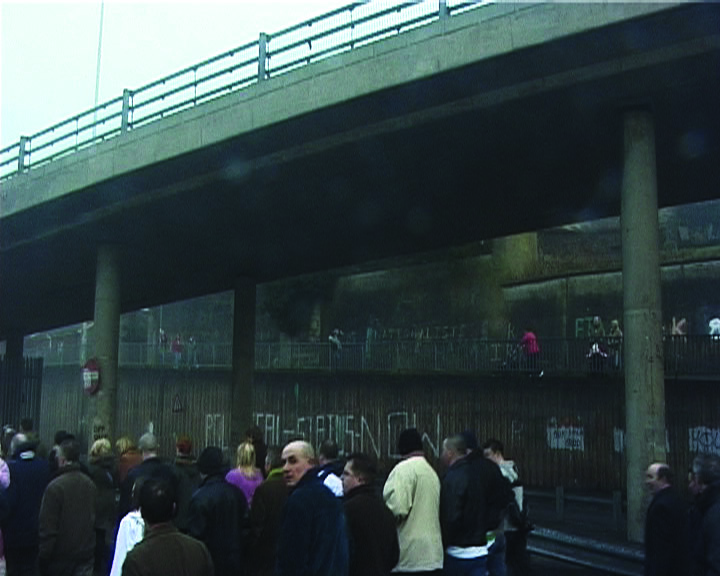
Valley of Jehosephat/Version – In Your Mind, Seamus Harahan, 2008
Seamus’ early masterpiece, Holylands (2003), which was filmed in an inner-city part of south Belfast so-called because its street names invoke Cairo, Palestine, Jerusalem, Damascus – Belfast’s legacy as a Victorian city ensures many street names are tied to imperial outposts and to the Christian faith of its founding fathers – comparably searches for moments of transcendence amidst discarded, ensnaring spaces, bursts of commonality and connection against the grain of the city’s limits and exclusions. The Holylands is a collision of more longstanding working-class communities and transient populations built on a sectarian fault line that has persisted during and beyond the conflict in the north of Ireland, blighted also by slum landlords and ruinous neglect. The Holylands often appears in the news and media as a site of ‘anti-social behaviour’, but Holylands, as with Cold Open and Seamus’ work as a whole, inverts that standard axiom of ‘anti-social behaviour’ by suggesting that it is the governing logic and polity of the city that is ‘anti-social’, dehumanising and alienating, while the people traced by the film are perpetually questing to be social, to be human and to be communal. The centrepiece of Holylands, in which people gather around a burst water main and bathe joyously in the sky-seeking surge of its torrent, exemplifies both Seamus’ films’ faith in people’s ability to reimagine and redeem a given place and his own artistic practice: his works are those effusions of lambency and transcendence that intervene and disrupt staid norms and ingrained perspectives. In the case of Holylands, it is precisely the breakdown of a putatively reforming and benign facet of the municipality and state – its water supply and the purely instrumental connection of the city – that gives way to this spontaneous reassembling of human connection and agency.
As with the other films, Holylands has already indicted the decayed promise of the state’s governing civics by emerging from one of its excluded zones and it replaces urban planning’s dead dreams of connection and function with a heavenly halo of light and movement that celebrates an undefeated and unsanctioned citizenship and agency. Indeed, early work like Tessies (2001) has demonstrated all along that Seamus’ work is deeply concerned with community and belonging but it seeks out those touchstones in more illicit ways beyond the readymade and sanctioned versions of identity, it yearns for recalcitrant and unruly pathways, those unbeaten tracks. As with the deployment of folk or traditional music in urban contexts alongside reggae, drum’n’bass, or art rock across the soundtrack of all his films, Tessies is a reminder that Seamus seeks out tradition in new ways, including retaining or reconvening new forms of custom and community amidst the alienations of modern, urban life, that his films are often modern, visual longings for stories and community and that there are the threads of a folk-story teller, singer or musician woven into an aesthetic and sonic patchwork that gathers his visual art together. In samurai (2006), with a soundtrack from Kode9’s “9 Samurai” that samples both the ominous march of Fumio Hayasaka’s Seven Samurai Suite, the score for Akira Kurosawa’s famous film, and the sonorous words of dub deity Lee ‘Scratch’ Perry – ‘a stone will be thrown at the state and a stone will be thrown at the churches’ – fugitive shots from the Belfast-Dublin train of the border between the northern and southern states in Ireland skilfully signal the similarity between both repressive entities and their ethno-religious hegemonies rather than endorsing the more standard account of their opposition and enmity.
In those kinds of terms, Valley of Jehoshaphat / In Your Mind (2008) is instructive too: it replays the same footage of the annual Bloody Sunday Commemoration march in Derry – the ongoing search for truth and justice in the wake of the Bloody Sunday massacre when British paratroopers murdered 14 Derry citizens in cold blood during a civil rights march on 30 January 1972 – firstly, using Max Romeo’s roots reggae track, ‘Valley of Jehoshaphat’ and its yearning for judgement and redress as part of a more communal, Afro-Caribbean cultural expression, and secondly, with Bryan Ferry’s ‘In Your Mind’, a more avowedly personal quest for salvation. Given that one of the many injustices heaped upon the mass murder itself by the British state was a dispute over what really happened, a dispute over truth, and a despicable process of victim-blaming over many decades, Seamus’ film is most certainly not a more relativised, postmodern pondering of whether representation ever reaches truth, an indeterminacy that would of course suit the British narrative of the event. Seamus’s film is, rather, an exploration of the quest for truth and justice, of which kinds of truth and justice are available to us, of how they are mediated and shaped by particular forms and narratives. As with many of his films, there is a liminal interplay between the personal and the communal and a yearning for the two to combine rather than oppose one another and, visually, again as with other works, there are times when the camera’s pixels are pushed beyond their limits to produce, paradoxically, a visionary blurring or an indefinite clarity that is very apt for Seamus’ quest for an as yet unrealised space of redemption in which the present might finally be reconciled.
Across all his work, Seamus is a really remarkable artist and filmmaker; not least because many of his films are declaredly immersed in what appears unremarkable or mundane but it is precisely his purpose to recalibrate and reimagine the world, especially in comradeship with the forgotten, the marginalised, the vanquished or the excluded. His imaginative repossession of the terrain in communion with the dispossessed, noticing the unnoticed, marking the unmarked, counting the unaccounted, is an egalitarian, highly creative, responsive, and loving embrace of everything that does not fit into dominant versions of the world. Seamus’ own humble and meticulous celebration, meagrely resourced yet imaginatively resourceful, of those recalcitrant residues and reminders itself deserves to be celebrated most widely and to be praised and acknowledged justly for his artistic skill, ethos, compassion, and creativity.
[1]Louis MacNeice, ‘Snow’. Collected Poems (London: Faber & Faber, 1966), p.30.
[2]Declan Long, ‘Seamus Harahan: Of Time and the City’. https://declanlongtexts.wordpress.com/2015/07/21/seamus-harahan-of-time-and-the-city/
[3]Eilidh Ratcliffe, Seamus Harahan: Both Together. Exhibition Essay. Glasgow: Glasgow School of Art, 2016.
[4]Carol Batton, ‘Beeing’. The full poem can be accessed at: http://www.bookcrossing.com/forum/5/396176/6293012
Dr Aaron Kelly holds a BA (Hons), MA in Irish Writing and PhD from Queen’s University Belfast. He was Leverhulme Postdoctoral Fellow in Irish and Scottish Literature at the University from 2001-2004 and was appointed a lecturer in September 2004.

